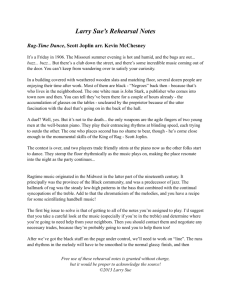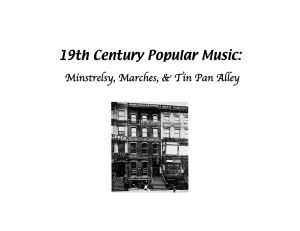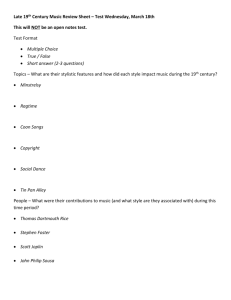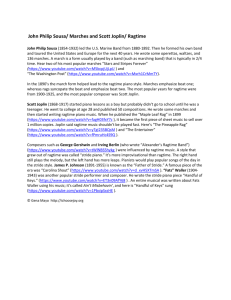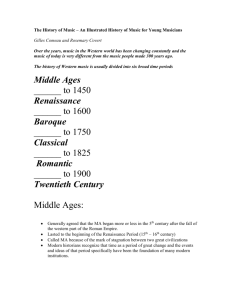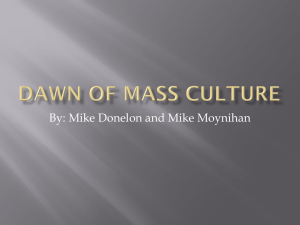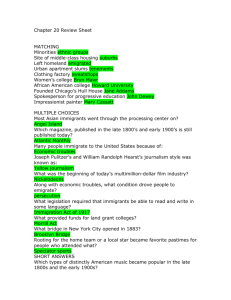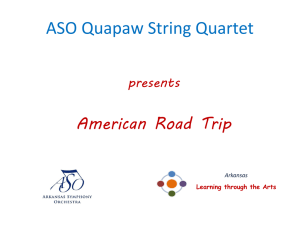The Sedalia Scott Joplin Ragtime Festival
advertisement
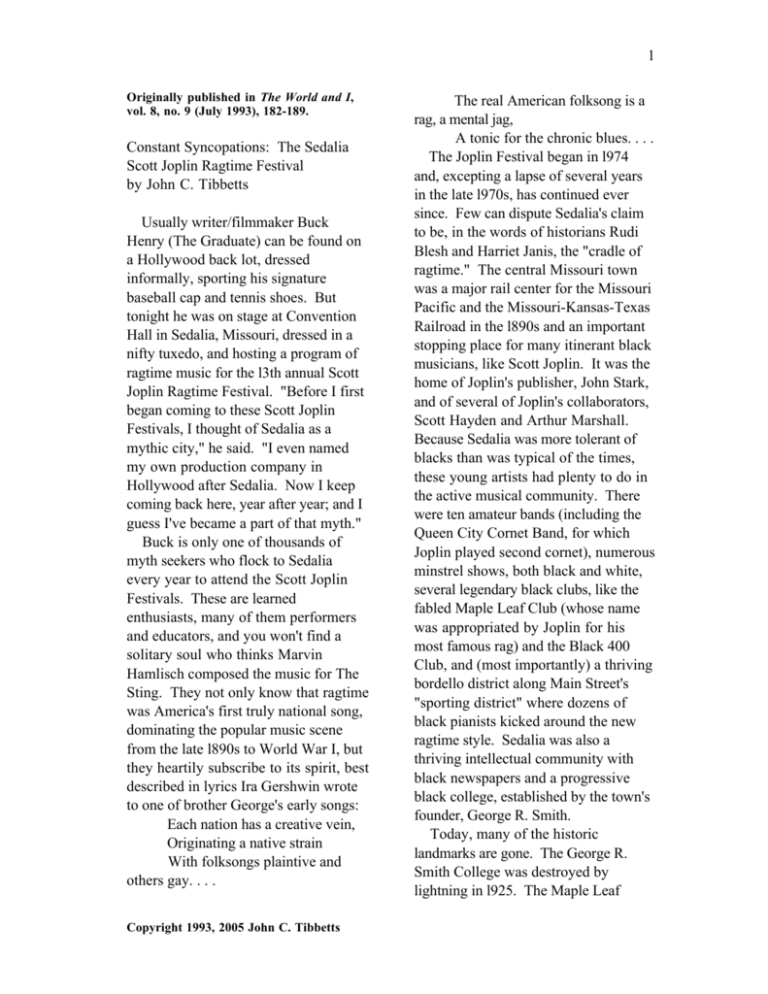
1 Originally published in The World and I, vol. 8, no. 9 (July 1993), 182-189. Constant Syncopations: The Sedalia Scott Joplin Ragtime Festival by John C. Tibbetts Usually writer/filmmaker Buck Henry (The Graduate) can be found on a Hollywood back lot, dressed informally, sporting his signature baseball cap and tennis shoes. But tonight he was on stage at Convention Hall in Sedalia, Missouri, dressed in a nifty tuxedo, and hosting a program of ragtime music for the l3th annual Scott Joplin Ragtime Festival. "Before I first began coming to these Scott Joplin Festivals, I thought of Sedalia as a mythic city," he said. "I even named my own production company in Hollywood after Sedalia. Now I keep coming back here, year after year; and I guess I've became a part of that myth." Buck is only one of thousands of myth seekers who flock to Sedalia every year to attend the Scott Joplin Festivals. These are learned enthusiasts, many of them performers and educators, and you won't find a solitary soul who thinks Marvin Hamlisch composed the music for The Sting. They not only know that ragtime was America's first truly national song, dominating the popular music scene from the late l890s to World War I, but they heartily subscribe to its spirit, best described in lyrics Ira Gershwin wrote to one of brother George's early songs: Each nation has a creative vein, Originating a native strain With folksongs plaintive and others gay. . . . Copyright 1993, 2005 John C. Tibbetts The real American folksong is a rag, a mental jag, A tonic for the chronic blues. . . . The Joplin Festival began in l974 and, excepting a lapse of several years in the late l970s, has continued ever since. Few can dispute Sedalia's claim to be, in the words of historians Rudi Blesh and Harriet Janis, the "cradle of ragtime." The central Missouri town was a major rail center for the Missouri Pacific and the Missouri-Kansas-Texas Railroad in the l890s and an important stopping place for many itinerant black musicians, like Scott Joplin. It was the home of Joplin's publisher, John Stark, and of several of Joplin's collaborators, Scott Hayden and Arthur Marshall. Because Sedalia was more tolerant of blacks than was typical of the times, these young artists had plenty to do in the active musical community. There were ten amateur bands (including the Queen City Cornet Band, for which Joplin played second cornet), numerous minstrel shows, both black and white, several legendary black clubs, like the fabled Maple Leaf Club (whose name was appropriated by Joplin for his most famous rag) and the Black 400 Club, and (most importantly) a thriving bordello district along Main Street's "sporting district" where dozens of black pianists kicked around the new ragtime style. Sedalia was also a thriving intellectual community with black newspapers and a progressive black college, established by the town's founder, George R. Smith. Today, many of the historic landmarks are gone. The George R. Smith College was destroyed by lightning in l925. The Maple Leaf 2 building was demolished in the late l950s, after suffering damage from several fires and a tornado. Actor Jack Oakie, a former Sedalia native and owner of the Maple Leaf, later declared that had he known the historical value of the structure, he would never have allowed it to be torn down. Nowadays, thanks to an active Scott Joplin Foundation, surviving landmarks are being located, identified, and preserved. It was announced at this year's Festival, for example, that two historic buildings, at ll4 and ll6 East Main, directly opposite the former site of the Maple Leaf Club, have been purchased. They mark the future site of the Scott Joplin Foundation offices and Museum. At times, during the long weekend of June 3-6, I felt I was in a most agreeable time warp. Sedalia was decked out in its turn-of-the-century ragtime best. White banners fluttered in the mild breezes. Ice cream socials advertised home-made ices and pies. Somebody was playing ragtime at every street corner and park, it seemed. Costumed bands with colorful names like the Blind Boone High Steppers, the St. Louis Ragtimers, the Paul Price Society Orchestra, and the Et Cetera String Band led parades. Performers with hothouse names like Sister Jean and Laundry Fat, as well as Festival reliables like Glenn Jenks, Dick Zimmerman, David Thomas Roberts, and Ian Whitcomb, performed at all hours in the three big white tents strung out along Main, Osage, and Ohio Streets. What a pleasant thing it was to stroll along, catching the vagrant strains Copyright 1993, 2005 John C. Tibbetts of the "Maple Leaf Rag," the quirky measures of the "Stop Time Rag," and the strange lyrics of forgotten music hall ditties. Ragtime is essentially dance music, as various commentators never failed to remind us; and one of the most popular daytime stops was Professor Desmond Strobel's Antique Academy of Genteel Dance at the Tea Time Dance Tent. Under the attentive eye of the good professor, men donned their derbies and spats, and women plucked up the hems of their long gowns to launch into a variety of two-steps, quadrilles, and waltzes. And if you think any of this is easy, just try it. . . . "This is one of the only music festivals I know of that brings a lot of the music to the people for free," explained Dick Zimmerman, renowned ragtime specialist and Music Director for all thirteen Festivals. "Much of it is right outside, on the main streets, where you can walk along and hear some of the world's top ragtime artists. We have the merchants of Sedalia, and the local Chamber of Commerce, to thank for that. And the people who come here take it all quite seriously, not just out of some half-baked nostalgia. They know it came out of hard times among the black people, but they also know it expressed something we don't find in today's popular music--an optimism and enthusiasm that young people had about themselves. Listen to our young people's music today. Do you hear anything positive?" The range of musical events was enormous and full of surprises. I have especially fond memories of an 3 afternoon concert in which a number of musicians played rags in unusual instrumental combinations--"Stop Time" on the xylophone, "Maple Leaf" in John Stark's arrangement for mandolin, guitar and banjo, and a song from Treemonisha for a capella voice duet. During one of the outdoor tent concerts Japanese pianist, Masanobu Ikemiya (who now presides over the Arcady Music Festivals in Maine) performed a program of ragtime parodies of classical music. "Almost everybody at the turn of the century was ragging the classics," Ikemiya explained, before sitting down to Felix Arndt's takeoff on Dvorak's famous "Humoresque"--aptly entitled "Desecration Rag." "This sort of thing caused the Musicians Union to raise a protest. Nowadays, ragtimers are still at it. William Albright's 'Night on Rag Mountain' is a great example." The evening concerts were also spiced with unexpected pleasures. Pianist Glenn Jenks performed a tribute to Will Marion Cook, a tantalizing medley of tunes from Cook's pioneering Broadway musical, In Dahomey (l902). The Paul Price Orchestra played Victor Herbert's delicious blend of Indian and Latin idioms, Panamericama (l90l). And William Bolcom and Joan Morris chose a delightful blend of music by Gershwin, Cole & Johnson, and Joplin. (Bolcom also played his own signature piece, the enchanting "Ghost Rag.") Renowned pianist Dick Hyman created a sensation with what might best be described as a "ragtime Jekyll and Hyde" routine. After sensitively negotiating his way through classic rags by Jelly Roll Morton and Joplin, he Copyright 1993, 2005 John C. Tibbetts reappeared minutes later in the guise of "Knuckles" O'Toole, a colorful personna he made popular in a series of recordings in the l950s. "Knuckles" tore through several outrageous rag pastiches using a piano that had been "prepared" a la John Cage (destroyed is perhaps a better way of putting it!), with paper strips and strings of paper clips that had been placed over the innards by colleague Dick Zimmerman. The routine brought down the house. And if you could stay awake long enough, some of the best music to be heard came later, much later, at the "After Hours" sessions at the local Best Western Hotel. Assorted performers appeared with all manner of wash boards, tubas, and other exotic instruments to let down their hair and take turns belting out "l2th Street Rag" in a kind of "Duel of the Ragtimers" that lasted well into the early morning hours. In this writer's opinion, the real heart of the Festival was the two-day series of symposia in Liberty Center headed by the distinguished ragtime historian and Joplin specialist Edward Berlin. These sessions were, for the most part, not dry exercises in academia attended by a mere handful of the faithful; rather, they were lively confrontations in a packed room that held at least four hundred people. Highlights included world premieres of two hitherto unknown rags by Joseph Lamb, presented by Joseph Scotti, who currently is editing Lamb's works for the Smithsonian Institution Press; slide tours of Sedalia's ragtime past by Joplin Foundation historian Robert Ault and 4 moderator Edward Berlin, and a discourse about the redoubtable Broadway comedienne, May Irwin, by John Graziano of the City University of New York. "Irwin's importance is now only being understood," Graziano said, as he guided his audience through slides and song demonstrations. "She introduced the syncopated song, or dialect song, to the Broadway musicals in the first decade of this century. She stands at the beginning of a new kind of American musical theater, a period of transition that led to the glory days of Tin Pan Alley. Before this you had popular songs influenced by Gilbert and Sullivan, Offenbach, and the Viennese waltz. She gave the dialect songs a boost and they became such a potent force that mainstream composers like Irving Berlin and Reginald De Koven-later Gershwin--began to write them." In my opinion one of the most valuable presentations was by pianist Tony Caramia of the Eastman School of Music. He took us into the musical workshop of Pulitzer-Prize winning composer William Bolcom, whose distinguished rags rank among his finest compositions. Describing them as "blatantly pianistic," Caramia selected a number of them for expressive, harmonic, and rhythmic analysis. Negotiating these fiendish pieces is difficult under any circumstances, he confided, but to have Bolcom and wife Joan Morris in the audience made it especially nerve-wracking! Yet Caramia's wit never failed him. While demonstrating the harmonic peculiarites of "The California Porcupine Rag," for example, Caramia cracked that it displayed "a left hand continuing a Copyright 1993, 2005 John C. Tibbetts search for intelligent life in some sort of tonic form." And concerning the relentlessly chromatic vagaries of the "Poltergeist Rag," he drily accused Bolcom of writing it "during a sale in accidentals at a local K-Mart." Caramia concluded the session with an uninterrupted performance of six rags, polishing off the set with a hair-raising rendition of Bolcom's spectacular "Serpent's Kiss." The audience went crazy while Bolcom, obviously moved, joined Caramia on the platform for a hug and some discussion. Bolcom is one of today's most active and prestigious proponents of the ragtime style and was responsible for the revival of Joplin's ragtime opera, Treemonisha. He even included what he calls "raggy" material in his recently premiered opera, McTeague. He reminded us of how new the current ragtime revival was. "In l967 few people even knew who Scott Joplin was," he said. "And so many people in the jazz community dismissed him as too 'academic,' too stiff, somebody whose works you didn't--and shouldn't fool around with. I had already done some 'raggy' stuff in my show, Dynamite Tonight in l963 and was teaching at Queen's College when Rudi Blesh [co-author of the seminal They all Played Ragtime, l950] brought my attention to Joplin's opera, Treemonisha. I just fell in love with the stuff. This was at a time when American music was overwhelmed by what I call the 'International Fellowship Style'--you know, you had to write atonal stuff to win a Guggenheim, or something. (It's still true, by the way!) We felt it was terribly limiting and I 5 wanted to write real tunes in two-four with key signatures and ending cadences and everything. It felt so good after being a card-carrying Modernist for so many years. Like Chopin Mazurkas, another body of dance music, rags are things that people think they can do themselves. You see, it's hard to listen and just sit there. And that's part of their value. But we haven't yet learned to treat them seriously, like jazz-although that's more out of guilt than real love." An underlying theme of the symposia--indeed, it simmered at the heart of the entire Festival, was the controversy surrounding the popular progenitor of the ragtime movement, the "coon song," or dialect song craze that swept the country in the l890s. Today, many historians of black culture are dismayed at the dialect song, whose typically racist lyrics, while popular in May Irwin's day and an important influence on the development of American popular song, are offensive to today's listeners. Everybody had something to say about the issue. "Ragtime songs were the first truly American songs," insisted Ian Whitcomb, a historian of popular song (After the Ball) and host of a nightly Los Angeles radio program on the subject. "And the dialect song, specifically, came out of our need to free ourselves from the puritannical strictures of victorian manners. Whites, particularly, saw in minstrel shows and the dialect songs an image of a black man or the black woman--the 'red hot mama'--a mythical image that was Copyright 1993, 2005 John C. Tibbetts powerful and even dangerous. But it was also liberating. I see this as typical of most eras in our popular music, from the cakewalk to rock 'n roll. The victim of all this, of course, was the black man. You can look at so many important black composers, like Will Marion Cook, who was essentially a bourgeois, European-trained composer, but who was forced to perpetuate the myth of the 'hot black man.'" "That's a whole era of songs that we can't do any longer," lamented Buck Henry who, like fellow actor George Segal, is an amateur ragtime musician. "And I can understand when a black person rejects the lyrics that refer to 'coons.' They are offensive. But the songs tell a story of survival and prevailing among the blacks that is really valuable. Personally, I'd like to hear more of these songs, but I can understand the objections." Bolcom and Morris, who performed Cole and Johnson's "Castle on the Nile" at one of the evening concerts, a song about a black man's yearning to return to Africa, explained their own ambivalence about the problem: "Our feelings are, in general, that we shouldn't do some of the more problemmatic songs in public. About ten years ago we used to do some Babe Conners numbers that May Irwin made so popular, like 'The New Bully,' which is about a swaggering black man. We did this at the Yale Cabaret and all the black students came up to us and thanked us for the chance to hear it. On the other hand, today there's a certain class of white liberal who practices a political correctness that verges on bigotry. Eubie Blake used to tell us that he was 6 accused of being an 'Uncle Tom' because he performed this kind of material. That's real nerve, if you ask us. We can't really know the pressures on blacks in the past to behave a certain way and perform a certain way. Let's not have this false Mrs. Grundy attitude that says, 'Don't touch that!' If you do these things at all nowadays you have to put them in quotes, apologize for them, that sort of thing. We feel that the time has come that people should put aside their discomfort and confront it head on." "I think there is too much posturing about black studies today," says Dick Zimmerman. "There aren't enough people willing to confront this aspect of ragtime, as we do here at the Festivals. And yet even here in Sedalia Copyright 1993, 2005 John C. Tibbetts we wish more black musicians and historians would attend. America is rediscovering its cultural roots and this is no time to sweep things like this under the carpet." In the end I'm left with a chance remark by Bill Bolcom at one of the symposia. Music, he said, any music, has no race, no ownership. "No one 'owns' ragtime," he said. "Once it's out, it's in the world and then it's for everybody." Maybe, in the final analysis, that's what a truly correct diversity is all about. John C. Tibbetts
